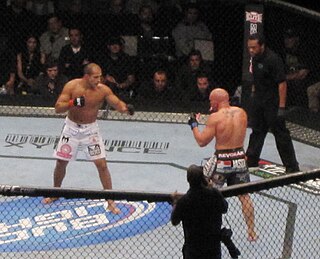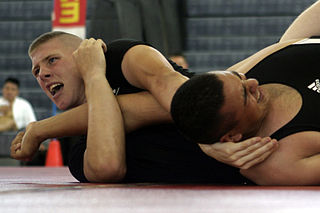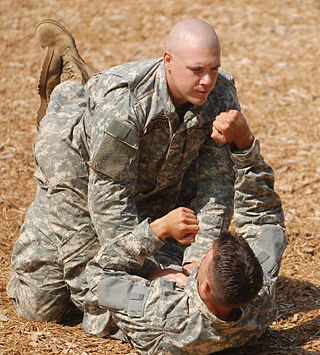
Grappling is a fighting technique based on throws, trips, sweeps, clinch fighting, ground fighting and submission holds.
Transition or transitional may refer to:

Brazilian jiu-jitsu, often abbreviated to BJJ, is a self-defense martial art and combat sport based on grappling, ground fighting, and submission holds. It is primarily a ground-based fighting style and focuses on taking one's opponent down to the ground, gaining a dominant position, and using a number of techniques to force them into submission via joint locks, chokeholds, or compression locks.

Mixed martial arts (MMA) is a full-contact fighting sport based on striking and grappling, incorporating techniques from various combat sports from around the world.
Professional wrestling holds include a number of set moves and pins used by performers to immobilize their opponents or lead to a submission. This article covers the various pins, stretches and transition holds used in the ring. Some wrestlers use these holds as their finishing maneuvers, often nicknaming them to reflect their character or persona. Moves are listed under general categories whenever possible.

Submission grappling, also known as submission wrestling, submission fighting, or simply grappling, is a martial art and combat sport that focuses on ground fighting and submission techniques. It is a hybrid discipline that incorporates elements of various martial arts such as various wrestling styles, judo, and Brazilian jiu-jitsu. Submission wrestling is practiced both as a competitive sport and as a training method for self-defence and mixed martial arts (MMA).

The guard is a ground grappling position in which one combatant has their back to the ground while attempting to control the other combatant using their legs. In pure grappling combat sports, the guard is considered an advantageous position, because the bottom combatant can attack with various joint locks and chokeholds, while the top combatant's priority is the transition into a more dominant position, a process known as passing the guard. In the sport of mixed martial arts, as well as hand-to-hand combat in general, it is possible to effectively strike from the top in the guard, even though the bottom combatant exerts some control. There are various types of guard, with their own advantages and disadvantages.

Ground fighting is hand-to-hand combat which takes place while the combatants are on the ground. The term is commonly used in mixed martial arts and other combat sports, as well as various forms of martial arts to designate the set of grappling techniques employed by a combatant that is on the ground. It is the main focus of Brazilian Jiu-Jitsu and is featured in varying amounts in Catch wrestling, Judo, Jujutsu, Sambo, Shoot wrestling, Dishuquan Dog Kung Fu, some schools of Shuai Jiao and other styles of wrestling.

The guillotine choke, also known as Mae Hadaka Jime in judo, is a chokehold in martial arts applied from in front of the opponent, often on the ground but can also be done while standing. The choke involves using the arms to encircle the opponent's neck that bears a resemblance to the blade of a guillotine.
An armlock in grappling is a single or double joint lock that hyperextends, hyperflexes or hyperrotates the elbow joint or shoulder joint. An armpit lock is very useful; it will immobilize an opponent and pin them on the ground. An armlock that hyperextends the elbow is known as an armbar, and it includes the traditional armbar, the shoulder triangle armbar, and the shotgun armbar. An armlock that hyper-rotates the arm is known as an armcoil, and includes the americana, kimura, and omaplata. Depending on the joint flexibility of a person, armcoils can either hyperrotate only the shoulder joint, only the elbow joint, or both the elbow joint and shoulder joint.

The mount, or mounted position, is a dominant ground grappling position, where one combatant sits on the other combatants torso with the face pointing towards the opponent's head. This is a favorable position for the top combatant in several ways. The top combatant can generate considerable momentum for strikes to the head of the opponent, while the bottom combatant is restricted by the ground and by the combatant on top. Other advantages include various chokeholds and joint locks that can be applied from the top. The bottom combatant will usually look to sweep the opponent or transition into a better position such as the guard.
Tsuyoshi Kosaka is a retired Japanese mixed martial artist, submission grappler and professional wrestler who competed in the Heavyweight division. A professional MMA competitor from 1994 till 2022, he has competed for the UFC, PRIDE Fighting Championships, RIZIN, RINGS, Pancrase, and DEEP. Kosaka is the former King of Pancrase Super Heavyweight Champion.

Clinch fighting or trapping is the part of stand-up fighting where the combatants are grappling in a clinch, typically using clinch holds. Clinching the opponent can be used to eliminate the opponent's effective usage of some kicks, punches, and melee weapons. The clinch can also be used as a medium to switch from stand-up fighting to ground fighting by using takedowns, throws or sweeps.

In grappling, side control is a dominant ground grappling position where the top combatant is lying perpendicularly over the face-up bottom combatant in such a way that the legs are free and he or she exerts no control over the combatant on the bottom. The top combatant is referred to as having side control, and is in a stable position, with the other combatant pinned beneath them. From there the top combatant can proceed with elbows, knees, various submissions, or transition into a mounted position. It is high priority for the bottom combatant to sweep the top combatant or otherwise escape the position, for instance by entangling the opponent's free legs and trying to obtain the half guard or guard.

A grappling hold, commonly referred to simply as a hold that in Japanese is referred to as katame-waza, is any specific grappling, wrestling, judo, or other martial art grip that is applied to an opponent. Grappling holds are used principally to control the opponent and to advance in points or positioning. The holds may be categorized by their function, such as clinching, pinning, or submission, while others can be classified by their anatomical effect: chokehold, headlock, joint-lock, or compression lock. Multiple categories may be appropriate for some of these holds.

In combat sports, the north–south position is a ground grappling position where one combatant is supine, with the other combatant invertedly lying prone on top, normally with their head over the bottom combatant's chest. The north–south position is a dominant position, where the top combatant can apply effective strikes such as knee strikes to the head, or easily transition into various grappling holds or more dominant positions. Transitioning into side control can be done by first switching into a particular hold known as ushiro-kesa-gatame (後袈裟固) or reverse scarf hold, where the chest points to the side, and the opponent's arm is controlled similarly to kesa-gatame. The north–south choke is employed exclusively from this position.

A grappling position refers to the positioning and holds of combatants engaged in grappling. Combatants are said to be in a neutral position if neither is in a more favourable position. If one party has a clear advantage such as in the mount they are said to be in a "dominant position". Conversely, the other party is considered to be in an inferior position, usually called "on the bottom", but in this case sometimes called the "under mount".

Knee-on-stomach, or knee-on-belly, knee-on-chest, knee-ride, knee mount, is a dominant ground grappling position where the top combatant places a knee on the bottom combatant's torso, and usually extends the other leg to the side for balance. This position is typically obtained from side control, simply by rising up slightly and putting a knee on the opponent's stomach or chest.

Kesa-Gatame (袈裟固) is one of the seven mat holds, Osaekomi-waza, of Kodokan Judo. In grappling terms, it is categorized as a side control hold. It is commonly referred to as scarfhold in English due to erroneous translation from Japanese; the 'scarf' in scarfhold is in reference not to a western neck scarf but instead to a Buddhist Monk's sash worn from the left shoulder towards the right hip which was formerly known as 'kesa'. It is also known in wrestling as the head and arm ride.

A sweep is either of two categories of martial arts techniques. From standing, sweeps are throws or takedowns that primarily use the legs to attack an opponent's legs. On the ground, sweeps are techniques for reversing a grappling position from a guard position.
















